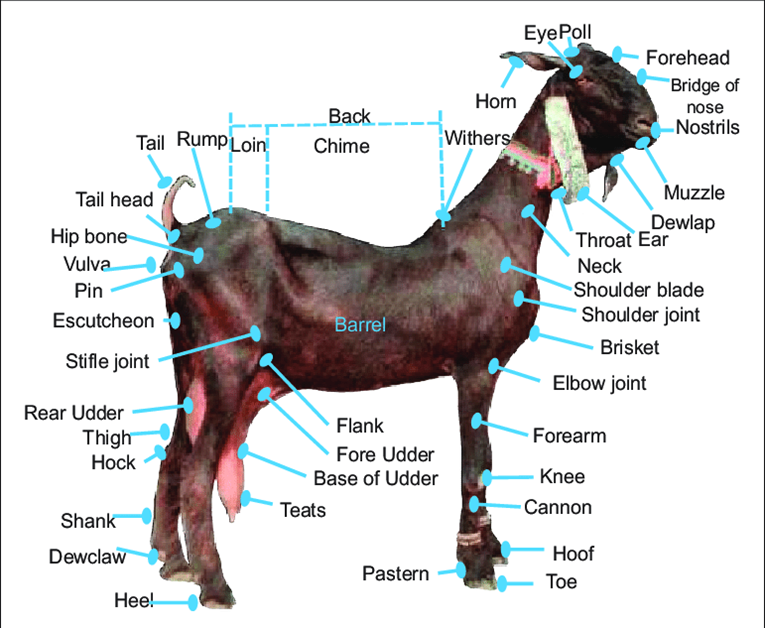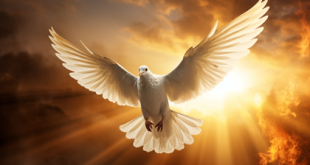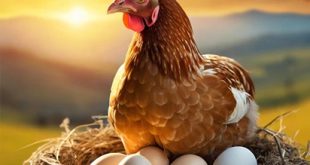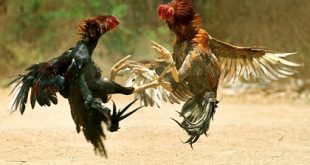Goats are fascinating creatures that play a significant role in agriculture, ecosystems, and even human culture. As ruminants, they belong to the Bovidae family and are characterized by their adaptability, hardiness, and unique physical features. Understanding the various body parts of a goat and their functions can provide insights into their biology, behavior, and care requirements. In this article, we will explore the major body parts of a goat and their respective roles in its daily life.
A Body Part of A Goat

1. Head and Skull
The head of a goat is a crucial structure that houses several sensory organs and supports essential functions.
- Eyes: Goats have horizontal rectangular pupils, which give them a broad field of vision—almost 320 to 340 degrees. This adaptation helps them detect predators while grazing.
- Ears: Goats have keen hearing, which aids in detecting sounds from predators or their surroundings. Some breeds, like the Nubian goat, have long, floppy ears that may help with thermoregulation.
- Nose: A goat’s nose is highly sensitive, enabling them to identify food, other goats, and environmental changes through smell.
- Mouth: The goat’s mouth contains a dental pad on the upper jaw and teeth on the lower jaw. This structure is ideal for tearing and grinding plant material. Their lips are also highly mobile, helping them pick specific plants.
- Horns: In most goat breeds, both males and females can have horns. These are used for defense, dominance displays, and occasionally for digging.
2. Neck
The neck of a goat connects the head to the body and contains vital structures such as the trachea and esophagus. It also houses lymph nodes and important blood vessels. The neck provides flexibility and strength, allowing the goat to graze, browse, and interact with its environment.
3. Forelimbs
The forelimbs of a goat are composed of the shoulders, legs, knees, and hooves. These parts work together to support the goat’s movement and balance.
- Shoulders: The shoulder muscles provide strength and mobility, enabling goats to climb and navigate rugged terrain.
- Legs: The sturdy legs are built for endurance and agility, allowing goats to travel long distances in search of food.
- Knees: These joints help in movement and are crucial for climbing and bending.
- Hooves: Goat hooves are cloven, meaning they are split into two toes. This unique structure provides excellent grip on rocky and uneven surfaces, making goats exceptional climbers.
4. Chest and Thorax
The chest houses vital organs, including the heart and lungs, protected by the ribcage. The thoracic cavity plays a crucial role in respiration and circulation.
- Heart: The heart pumps oxygenated blood throughout the goat’s body, ensuring proper functioning of all organs.
- Lungs: The lungs facilitate gas exchange, allowing the goat to breathe in oxygen and expel carbon dioxide.
5. Abdomen
The abdominal region is vital for digestion and reproduction.
- Rumen: As ruminants, goats have a specialized four-chambered stomach comprising the rumen, reticulum, omasum, and abomasum. The rumen is the largest chamber and serves as a fermentation vat, breaking down fibrous plant material with the help of microbes.
- Intestines: The small and large intestines are responsible for nutrient absorption and waste elimination.
- Liver: The liver detoxifies substances and metabolizes nutrients, playing a crucial role in overall health.
6. Udder (in Females)
The udder is a mammary gland found in female goats and is essential for milk production. It consists of two halves, each with a teat. Milk is produced in response to hormonal signals, primarily after giving birth. Goat milk is rich in nutrients and serves as a primary source of sustenance for kids (young goats).
7. Reproductive Organs
The reproductive organs differ between male and female goats, but both are essential for propagation.
- Females (Does): The uterus, ovaries, and oviducts are critical for reproduction. The estrous cycle determines when a female goat is fertile and ready for breeding.
- Males (Bucks): Bucks have testes that produce sperm and testosterone. They also possess scent glands near their horns, which play a role in attracting females during the breeding season.
8. Hind Limbs
The hind limbs are similar in structure to the forelimbs but are more robust to support the goat’s weight and propulsion.
- Thighs: The strong thigh muscles enable jumping and climbing.
- Hocks: These joints act as shock absorbers and provide flexibility.
- Hooves: Like the forelimbs, the hooves on the hind limbs ensure stability and traction.
9. Tail
The goat’s tail serves various functions, including communication and hygiene. For example, goats may wag their tails to deter flies or as a sign of contentment. Observing the position and movement of a goat’s tail can also provide clues about its health and mood.
10. Skin and Coat
The skin and coat protect the goat from environmental factors and help regulate body temperature.
- Skin: Acts as a barrier against pathogens and prevents water loss. It also contains sweat glands that aid in thermoregulation.
- Coat: The coat varies by breed and can be short, long, or even woolly. It provides insulation during cold weather and sheds in warmer months.
11. Skeletal System
The skeletal system provides structure and support to the goat’s body. It consists of bones, joints, and cartilage.
- Spine: The spine allows flexibility and movement while protecting the spinal cord.
- Ribs: These protect vital organs such as the heart and lungs.
- Limbs: The bones in the limbs are strong yet lightweight, ensuring agility and endurance.
12. Nervous System
The nervous system controls all bodily functions and responses.
- Brain: The brain processes sensory information and coordinates behavior.
- Spinal Cord: Transmits signals between the brain and the rest of the body.
- Nerves: Facilitate communication between organs and the brain, enabling movement and responses to stimuli.
13. Circulatory System
The circulatory system includes the heart, blood vessels, and blood. It ensures the distribution of oxygen, nutrients, and hormones throughout the body while removing waste products.
14. Respiratory System
The respiratory system consists of the nasal passages, trachea, lungs, and diaphragm. It is responsible for breathing and oxygen exchange, vital for cellular function.
15. Digestive System
The goat’s digestive system is adapted to process fibrous plant materials efficiently. The four-chambered stomach allows fermentation and breakdown of tough cellulose, enabling goats to extract nutrients from a wide variety of plants.
Conclusion
Each body part of a goat is uniquely adapted to support its survival, reproduction, and interaction with the environment. From their keen senses and agile limbs to their specialized digestive system, goats are remarkably well-equipped for life in diverse habitats. Understanding these features not only helps in appreciating these animals but also ensures better care and management for those who raise them. By recognizing the roles and functions of their body parts, we can foster a deeper connection with these intelligent and versatile creatures.


